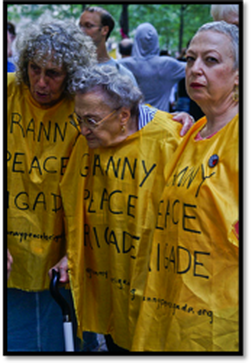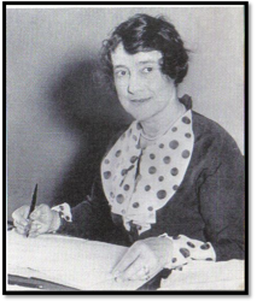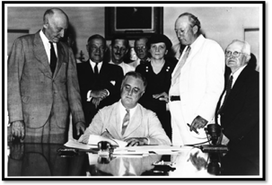 The Granny Brigade at Occupy Wall Street
The Granny Brigade at Occupy Wall Street But there was a consumer activist—a woman—born over a century ago, who would not have been surprised at all. Her name was Mary Harriman Rumsey, and she was the partner of Roosevelt’s Secretary of Labor, Frances Perkins.
Frances Perkins was the first woman to occupy a Cabinet position, and she has rightly been referred to as the “woman behind the New Deal.” Her achievements include the banning of child labor, the minimum wage, the forty-hour workweek, worker's compensation, unemployment insurance, employer-provided health insurance, new work programs to create jobs, welfare, and Social Security. The only item on her reform agenda that she failed to secure was universal health insurance. The American Medical Association had as influential a lobby then as now.
(It’s an interesting footnote to history that while the Bureau of Immigration was still under the Labor Department, Perkins fought hard but unsuccessfully to allow entry for hundreds of thousands of Jews fleeing Nazi persecution. Roosevelt transferred the Bureau to the Department of Justice in 1940, but had he not authorized this transfer, Perkins would never have allowed the infamous internment camps for American citizens of Japanese descent.)
Perkins had made many adjustments early in her career in order to fit herself into the male-dominated arena of politics. She had changed her name (from “Fannie” to Frances) and also her style of dressing (to remind men of their mothers!) But after her Cabinet appointment, she found herself in a Catch-22 situation.
 Mary Harriman Rumsey
Mary Harriman Rumsey And here is where Mary Harriman Rumsey came to the rescue. She rented a three-story house in Georgetown and invited Frances to become her “roommate.” History notes that the two were far more than roommates, and that Mary was far more than a typical Cabinet wife.
Mary Rumsey was the daughter of a railroad tycoon, and she had grown up on a twenty-thousand-acre estate in upstate New York, where she later supervised the six hundred employees. She had homes on Long Island and also in Virginia. Her dinner parties with Frances were legendary, and, as one biographer noted, it was not unusual to find Will Rogers, Eleanor Roosevelt, Margaret Bourke-White, and General Douglas MacArthur at her table, along with an unknown Appalachian folk singer.
During Roosevelt’s inaugural year, she founded a Washington weekly named Today, which later became Newsweek magazine. More significantly, Roosevelt named her to chair the Consumer Advisory Board that had been authorized under the New Deal.
 Perkins Overseas Social Security signing
Perkins Overseas Social Security signing "There have been disagreements between labor and capital in which each has made known its ills, but seldom has the man or woman who actually footed the bills, by purchasing the things that were manufactured or grown, had a voice in the selling price."
Sadly, this principle was forgotten in the decades following the New Deal, when credit cards were introduced to consumers. By the 1970’s the price of goods and services was increasing at a rate higher than wages, but nobody seemed to notice because, suddenly, even working-class folks could get instant “mini-loans” via credit cards for all kinds of purchases that did not require loan officer approval. Magic money! By the 1990’s, the debt load of an average family was $40,000. By that same decade, the credit craze had spread to the housing market, where lack of adequate regulation led to hundreds of thousands of folks taking out mortgages on homes that would be one paycheck away from foreclosure.
Mary Rumsey would have seen right through this smokescreen of a credit economy, to the widening gap between wage and price increases. And she would have decried a government willing to allow its citizens to be seduced by promises of instant gratification and the trappings of upward mobility, even as they slid deeper and deeper into hopeless debt.
Mary died suddenly and unexpectedly on December 19, 1934, from complications resulting from a fall from a horse. At the time of her death, Frances was in middle of the fight for Social Securty, and Roosevelt had given her a Christmas deadline for her Cabinet committee to complete their work. Because of the closeted nature of her relationship with Rumsey, only a few very close (and lesbian) friends could acknowledge the degree of her loss. As one of these friends noted, “You are going through one of those tremendously alone experiences, yet lacking in importance outside yourself.” Frances would also lose their home, as it was Rumsey who had paid the lion’s share of the rent. Any attempt on the part of Rumsey to provide for Perkins financially would have raised questions on scandal-mongering Capitol Hill.
So, the same week her partner died and she was facing the imminent loss of her home, Perkins called the members of her committee to her home, set a large bottle of Scotch on the table, and told the men that no one went home until they finished the work. As a result of that night, and the woman whose activism was a living memorial to her partner’s death, millions of Americans have been able to retire, and even more have been able to survive.
Watching, the footage of the Occupation of Wall Street, one hears the echo of Mary Rumsey. In this interview, she was referring to her multi-millionaire father, but her words could as easily be applied to the “banksters” of Wall Street today:
"His period was a building age, when competition was the order of the day. Today the need is not for a competitive but for a cooperative economic system."
References: Downey, Kirstin. The Woman Behind the New Deal: The Life of Frances Perkins, FDR'S Secretary of Labor and His Moral Conscience. Doubleday, 2009.
Mitchell, Donn. “Debutantes of the World, Unite! The Irrepressible Mary Harriman” The Anglican Examiner, http://www.anglicanexaminer.com/Rumsey.html
[Originally published in On the Issues: A Magazine of Feminist, Progressive Thinking, Nov. 23, 2011.]

 RSS Feed
RSS Feed
